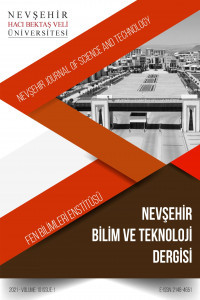Baryum Karbonat İlavesinin Porselen Seramik Karoların Özelliklerine Etkisi
Baryum karbonat, ergitici, porselen karo
Effect of Barium Carbonate Addition on the Properties of Porcelain Ceramic Tile
: Barium carbonate, flux, porcelain tile,
___
- [1] Jorge M., Jesús R., Maximina R., “Mullite development on firing in porcelain stoneware bodies” Journal of European Ceramic Society, 30, 1599-1607, 2010. [2] Sanchez E., Ibanez M.J., Garcia-Ten J., Quereda M.F., Hutchings I.M., Xu Y.M., “Porcelain tile microstructure: implications for polished tile properties” Journal of European Ceramic Society, 26, 2533–2540, 2006. [3] Vieira C.M.F., Peçanha L.A., Monteiro S.N., “Effect of kaolinitic clays from the State of Rio de Janeiro in the composition of whiteware floor tile bodies” Cerâmica, 52, 138-145, 2006. [4] Wu J., Li K., Xu X., Zhang Y., Xu, X., Lao X., “White porcelain material based on diopside” International Journal of Applied Ceramic Technology, 14, 454–460, 2017. [5] Khalil N.M., Wahsh M.M.S., Gaber A., “The effect of albite additions on the sintering, phase compositions and microstructure of vitreous ceramic tiles” Journal of Ceramic Processing Research, 17, 478-484, 2016. [6] Serra M.F., Conconi M.S., Suarez G., Aglietti E.F., Rendtroff N.M., “Volcanic ash as flux in clay based triaxial ceramic materials, effect of the firing temperature in phases and mechanical properties” Ceramics international, 41(5), 6169-6177, 2015. [7] Mukhopadhyay T.K., Das M., Ghosh S., Chakrabarti S., Ghatak S., “Microstructure and thermomechanical properties of a talc doped stoneware composition containing illitic clay” Ceramics International, 29, 587-597, 2003.
- ISSN: 2148-466X
- Yayın Aralığı: Yılda 2 Sayı
- Başlangıç: 2012
- Yayıncı: Nevşehir Hacı Bektaş Veli Üniversitesi
3 Fazlı Evirici Devresi için SDGM, SHEDGM, HIDGM ve UVDGM Tekniklerinin Karşılaştırılması
Ayşe Kocalmış Bilhan, Sedat Sünter
Fren Sürtünme Malzemelerinde Aşındırıcıların (Alümina, Silika, Zirkon) Tribolojik Özellikleri
Effect of Different Metal Oxides On Vickers Hardness of the Frit Based Crystalline Glazes
Annelerin Çocuk Besleme Uygulamaları ve Çocukların Yemek Yeme Davranışları
Serap BALABAN, Yahya ÖZDOĞAN, Aslı UÇAR
Baryum Karbonat İlavesinin Porselen Seramik Karoların Özelliklerine Etkisi
Hülya KAFTELEN ODABAŞI, Ümit Engin ANIL, Akın ODABAŞI, Battal Kadir KOCABIYIK
Kapadokya Bölgesi Nevşehir Yöresi Kültürel Varlıklarının Bozulmalarına Neden Olan Etmenler
Günlenmeye Bağlı Oluşan Şekiller ve Yerleşme Üzerine Etkileri, Gümüşhane Örneği
Ali İMAMOĞLU, Selim ERASLAN, Halil ÇOT
Biyomedikal Uygulamalar İçin Titanyum Esaslı Gözenekli TiNb Alaşımının Üretimi
Mehmet KAYA, Abdurrahman YOLUN, Ömer ÇAKMAK, Fahrettin YAKUPHANOĞLU, Ebru ELİBOL, Mustafa KÖM, Mehmet GÜVENÇ
